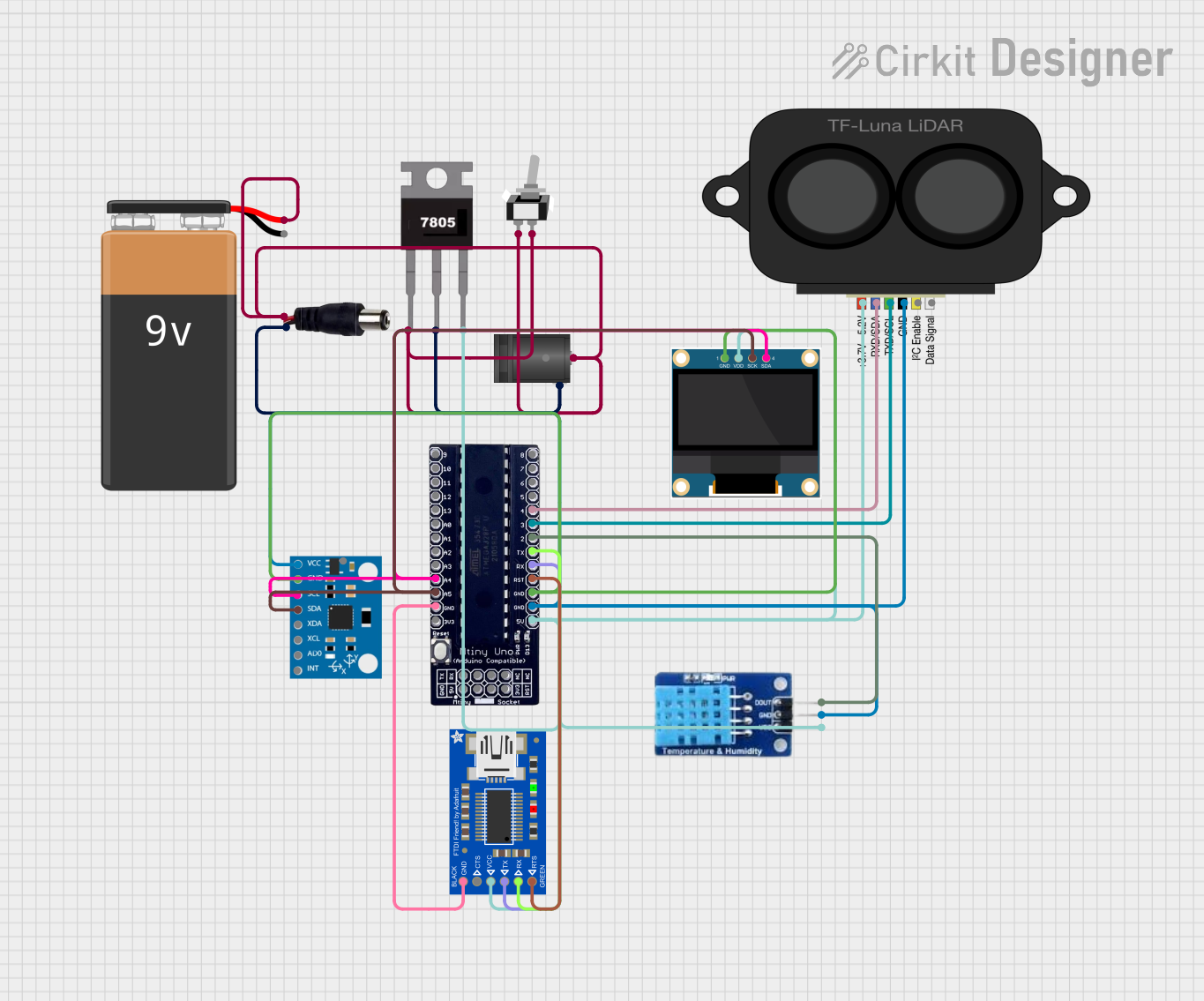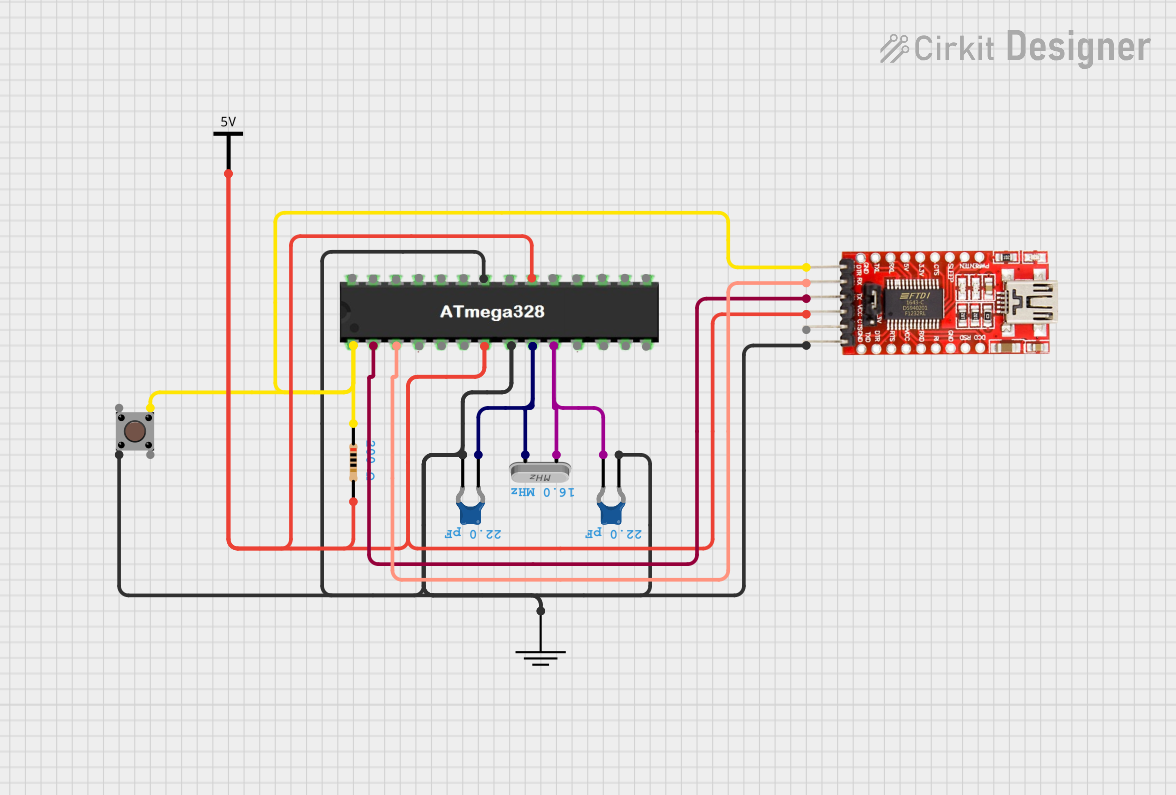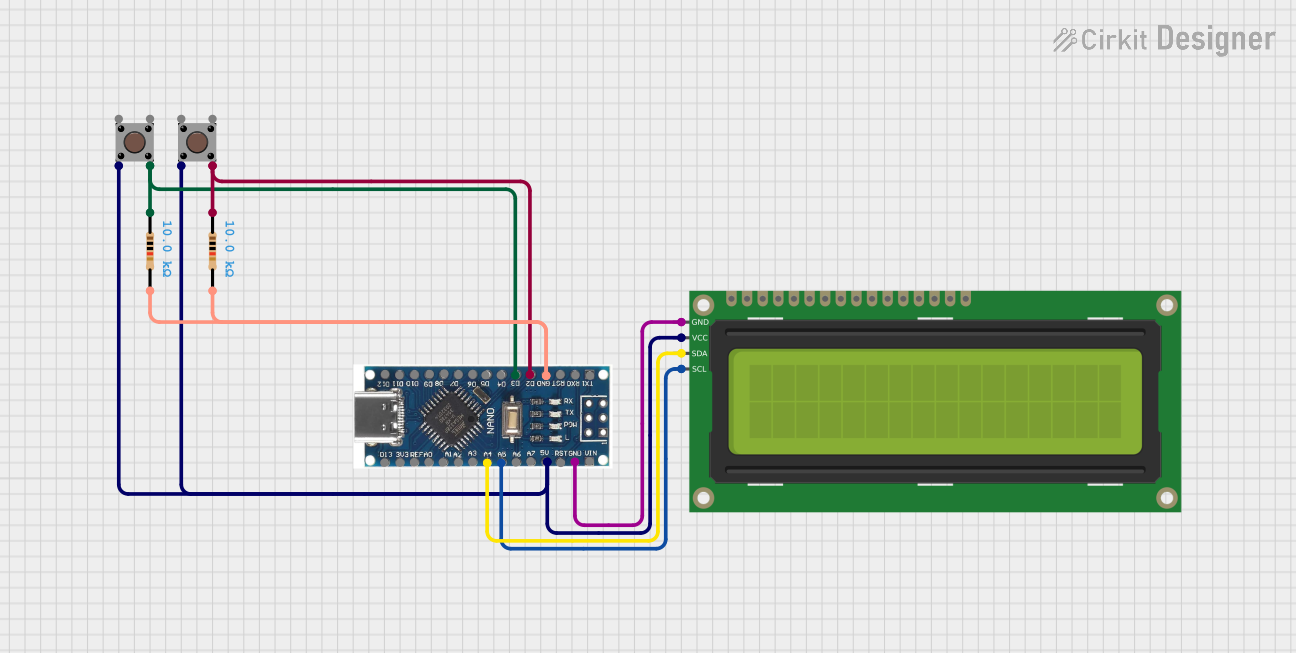
Cirkit Designer
Your all-in-one circuit design IDE
Home /
Component Documentation
How to Use ATmega328P IC: Examples, Pinouts, and Specs

 Design with ATmega328P IC in Cirkit Designer
Design with ATmega328P IC in Cirkit DesignerIntroduction
The ATmega328P is a low-power, 8-bit CMOS microcontroller based on the AVR enhanced RISC architecture. Manufactured by Atmel (now part of Microchip Technology), it is well-known for its role as the heart of the Arduino Uno and other Arduino variants. This microcontroller is suitable for a wide range of applications, from simple hobbyist projects to sophisticated industrial controllers due to its versatility, reliability, and ease of use.
Explore Projects Built with ATmega328P IC
ATMEGA328 Battery-Powered LED Blinker with FTDI Programming

This circuit is a basic microcontroller setup using an ATMEGA328, powered by a 5V battery, and includes an FTDI programmer for serial communication. It features a pushbutton for reset functionality and two LEDs controlled by the microcontroller, with one LED blinking at a 1-second interval as programmed.
 Open Project in Cirkit Designer
Open Project in Cirkit DesignerATmega328P-Based Sensor Hub with OLED Display and LIDAR

This circuit features an Mtiny Uno ATmega328P microcontroller as its central processing unit, interfacing with a variety of sensors and peripherals. It includes a 0.96" OLED display and an MPU6050 accelerometer/gyroscope for user interface and motion sensing, respectively. The circuit also integrates a TF LUNA LIDAR for distance measurement, a DHT11 sensor for temperature and humidity readings, and uses a 9V battery with a 7805 voltage regulator for power management. Communication with a computer for programming and data exchange is facilitated by an Adafruit FTDI Friend module.
 Open Project in Cirkit Designer
Open Project in Cirkit DesignerATMEGA328 Microcontroller Circuit with Serial Programming Interface

This circuit features an ATMEGA328 microcontroller configured with a crystal oscillator for precise timing, and a pushbutton for reset functionality. An FTDI Programmer is connected for serial communication, allowing for programming and data exchange with the microcontroller.
 Open Project in Cirkit Designer
Open Project in Cirkit DesignerArduino Nano Controlled LCD Interface with Pushbutton Inputs

This circuit features a Nano 3.0 ATmega328P microcontroller connected to a 16x2 I2C LCD display for output. Two pushbuttons, each with a 10k Ohm pull-down resistor, are connected to digital pins D2 and D3 of the microcontroller for input. The LCD and pushbuttons are powered by the 5V output from the microcontroller, and all components share a common ground.
 Open Project in Cirkit Designer
Open Project in Cirkit DesignerExplore Projects Built with ATmega328P IC

ATMEGA328 Battery-Powered LED Blinker with FTDI Programming
This circuit is a basic microcontroller setup using an ATMEGA328, powered by a 5V battery, and includes an FTDI programmer for serial communication. It features a pushbutton for reset functionality and two LEDs controlled by the microcontroller, with one LED blinking at a 1-second interval as programmed.
 Open Project in Cirkit Designer
Open Project in Cirkit Designer
ATmega328P-Based Sensor Hub with OLED Display and LIDAR
This circuit features an Mtiny Uno ATmega328P microcontroller as its central processing unit, interfacing with a variety of sensors and peripherals. It includes a 0.96" OLED display and an MPU6050 accelerometer/gyroscope for user interface and motion sensing, respectively. The circuit also integrates a TF LUNA LIDAR for distance measurement, a DHT11 sensor for temperature and humidity readings, and uses a 9V battery with a 7805 voltage regulator for power management. Communication with a computer for programming and data exchange is facilitated by an Adafruit FTDI Friend module.
 Open Project in Cirkit Designer
Open Project in Cirkit Designer
ATMEGA328 Microcontroller Circuit with Serial Programming Interface
This circuit features an ATMEGA328 microcontroller configured with a crystal oscillator for precise timing, and a pushbutton for reset functionality. An FTDI Programmer is connected for serial communication, allowing for programming and data exchange with the microcontroller.
 Open Project in Cirkit Designer
Open Project in Cirkit Designer
Arduino Nano Controlled LCD Interface with Pushbutton Inputs
This circuit features a Nano 3.0 ATmega328P microcontroller connected to a 16x2 I2C LCD display for output. Two pushbuttons, each with a 10k Ohm pull-down resistor, are connected to digital pins D2 and D3 of the microcontroller for input. The LCD and pushbuttons are powered by the 5V output from the microcontroller, and all components share a common ground.
 Open Project in Cirkit Designer
Open Project in Cirkit DesignerCommon Applications and Use Cases
- DIY electronics and Arduino projects
- Sensor data logging and processing
- Motor control systems
- Home automation
- Battery-operated devices
- Prototyping and educational tools
Technical Specifications
Key Technical Details
- Architecture: 8-bit AVR
- Operating Voltage (Vcc): 1.8 - 5.5V
- Input Voltage (recommended): 7-12V (when used with Arduino board)
- Clock Speed: Up to 20MHz
- Flash Memory: 32KB (0.5KB used by bootloader when used with Arduino)
- SRAM: 2KB
- EEPROM: 1KB
- I/O Pins: 23
- Analog Input Pins: 6 (10-bit ADC)
- PWM Channels: 6
- UART: 1
- SPI: 1
- I2C (TWI): 1
- Interrupts: External and internal
Pin Configuration and Descriptions
| Pin Number | Name | Function |
|---|---|---|
| 1 | PC6 | Reset |
| 2-3 | PD0-PD1 | Serial (RX/TX) |
| 4-5 | PD2-PD3 | External Interrupts (INT0/INT1) |
| 6-11 | PD4-PD7, PB0-PB1 | Digital I/O Pins |
| 12-19 | PB2-PB5, PC0-PC5 | Digital I/O Pins, Analog Inputs |
| 20-22 | AVCC, GND, AREF | Power Supply and Reference Voltage |
| 23-28 | PC1-PC6 | Analog Inputs, I2C (SDA/SCL) |
| 29-32 | PD6-PD7, PB0-PB1 | Digital I/O Pins, PWM |
| - | AGND, VCC | Ground, Power Supply |
Usage Instructions
How to Use the Component in a Circuit
- Powering the IC: Ensure that the ATmega328P is powered with a stable voltage between 1.8V and 5.5V. For Arduino boards, this is typically handled by the onboard voltage regulator.
- Clock Source: Connect an external crystal oscillator or a ceramic resonator between pins 9 and 10 if a precise clock source is needed.
- Programming: The ATmega328P can be programmed via the SPI interface (pins 17-19, 1). For Arduino boards, the bootloader allows programming via the onboard USB connection.
- I/O Configuration: Configure the I/O pins according to the needs of your application, taking care to respect the maximum current ratings.
Important Considerations and Best Practices
- Use decoupling capacitors (typically 100nF) close to the VCC and GND pins to stabilize the power supply.
- Ensure that the total current through the VCC or GND pins does not exceed the specified limits.
- Avoid exposing the IC to temperatures outside the specified operating range.
- Use a pull-up resistor on the RESET pin to prevent unintended resets.
Troubleshooting and FAQs
Common Issues Users Might Face
- Microcontroller not responding: Ensure that the power supply is connected correctly and the clock source is functioning.
- Incorrect behavior in circuits: Double-check the pin configuration and ensure that the I/O pins are configured correctly in the software.
- Programming errors: Verify the connections to the SPI pins and ensure that the correct bootloader is used if programming through the Arduino IDE.
Solutions and Tips for Troubleshooting
- If the ATmega328P is unresponsive, check the power supply and reset line.
- For programming issues, ensure that the correct device is selected in the programming software and that the drivers are installed.
- Use a multimeter to check for shorts or open circuits in the connections.
Example Code for Arduino UNO
// Blink an LED connected to pin 13 on an Arduino Uno
void setup() {
pinMode(13, OUTPUT); // Set digital pin 13 as an output
}
void loop() {
digitalWrite(13, HIGH); // Turn the LED on
delay(1000); // Wait for a second
digitalWrite(13, LOW); // Turn the LED off
delay(1000); // Wait for a second
}
Note: The above code is a simple example to demonstrate the usage of the ATmega328P on an Arduino Uno. The actual implementation may vary based on the application requirements.
For more advanced usage and detailed programming information, refer to the ATmega328P datasheet and the Arduino language reference.